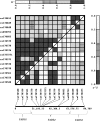Maternal single nucleotide polymorphisms in the fatty acid desaturase 1 and 2 coding regions modify the impact of prenatal supplementation with DHA on birth weight
- PMID: 26912491
- PMCID: PMC4807702
- DOI: 10.3945/ajcn.115.121244
Maternal single nucleotide polymorphisms in the fatty acid desaturase 1 and 2 coding regions modify the impact of prenatal supplementation with DHA on birth weight
Abstract
Background: Specific single nucleotide polymorphisms (SNPs) in the fatty acid desaturase (FADS) gene affect the activity and efficiency of enzymes that are responsible for the conversion of polyunsaturated fatty acids (PUFAs) into their long-chain active form. A high prevalence of SNPs that are associated with slow PUFA conversion has been described in Hispanic populations.
Objective: We assessed the heterogeneity of the effect of prenatal supplementation with docosahexaenoic acid (DHA) on birth weight across selected FADS SNPs in a sample of Mexican women and their offspring.
Design: We obtained information on the maternal genotype from stored blood samples of 654 women who received supplementation with 400 mg DHA/d or a placebo from weeks 18 to 22 of gestation through delivery as part of a randomized controlled trial conducted in Cuernavaca, Mexico. We selected 4 tag SNPs (rs174455, rs174556, rs174602, and rs498793) in the FADS region for analysis. We used an ANOVA to test for the heterogeneity of the effect on birth weight across each of the 4 SNPs.
Results: The mean ± SD birth weight was 3210 ± 470 g, and the weight-for-age z score (WAZ) was -0.24 ± 1.00. There were no intention-to-treat differences in birth weights. We showed significant heterogeneity by SNP rs174602 (P= 0.02); offspring of carriers of alleles TT and TC in the intervention group were heavier than those in the placebo group (WAZ: -0.13 ± 0.14 and -0.20 ± 0.08 compared with -0.55 ± 0.15 and -0.39 ± 0.09, respectively); there were no significant differences in offspring of rs174602 CC homozygotes (WAZ: -0.26 ± 0.09 in the intervention group compared with -0.04 ± 0.09 in the placebo group). We showed no significant heterogeneity across the other 3 FADS SNPs.
Conclusion: Differential responses to prenatal DHA supplementation on the basis of the genetic makeup of target populations could explain the mixed evidence of the impact of DHA supplementation on birth weight. This trial was registered at clinicaltrials.gov as NCT00646360.
Keywords: DHA; FADS; birth weight; long-chain PUFAs; prenatal supplementation.
© 2016 American Society for Nutrition.
Figures




References
-
- Martini I, Di Domenico EG, Scala R, Caruso F, Ferreri C, Ubaldi FM, Lenzi A, Valensise H. Optimization of the viability of stem cells derived from umbilical cord blood after maternal supplementation with DHA during the second or third trimester of pregnancy: study protocol for a randomized controlled trial. Trials 2014;15:164. - PMC - PubMed
-
- Koletzko B, Lien E, Agostoni C, Bohles H, Campoy C, Cetin I, Decsi T, Dudenhausen JW, Dupont C, Forsyth S, et al. The roles of long-chain polyunsaturated fatty acids in pregnancy, lactation and infancy: review of current knowledge and consensus recommendations. J Perinat Med 2008;36:5–14. - PubMed
-
- Campoy C, Escolano-Margarit MV, Anjos T, Szajewska H, Uauy R. Omega 3 fatty acids on child growth, visual acuity and neurodevelopment. Br J Nutr 2012;107:S85–106. - PubMed
-
- Damsgaard CT, Molgaard C, Matthiessen J, Gyldenlove SN, Lauritzen L. The effects of n-3 long-chain polyunsaturated fatty acids on bone formation and growth factors in adolescent boys. Pediatr Res 2012;71:713–9. - PubMed
-
- Innis SM. Essential fatty acids in growth and development. Prog Lipid Res 1991;30:39–103. - PubMed
Publication types
MeSH terms
Substances
Associated data
Grants and funding
LinkOut - more resources
Full Text Sources
Other Literature Sources
Medical

